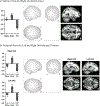Resting state functional connectivity in alcohol users and co-users of other substances
- PMID: 35217411
- PMCID: PMC9040506
- DOI: 10.1016/j.pscychresns.2022.111461
Resting state functional connectivity in alcohol users and co-users of other substances
Abstract
Polysubstance use (PSU) is the use of more than one psychoactive substance simultaneously or independently, and occurs in roughly half of individuals who seek treatment for substance use. The current study sought to use resting state functional connectivity (rs-FC) to examine functional connectivity in participants who report using multiple or single substances. Participants were drawn from a larger neuroimaging study. From there, participants were placed into one of three groups based on their frequency of alcohol, tobacco, cannabis, and illicit drug use. The final sample consisted of 82 participants. We observed three clusters that differed significantly between the three groups; one within the salience network and two within the temporal network. Tri+ users were found to have a lesser amount of rs-FC in these regions (compared to the other two groups) and dual users were found to have a greater amount of rs-FC within these regions. Findings indicate that use of three or more substances may significantly impact rs-FC within the salience and temporal networks, and that those who use alcohol+cannabis have significantly greater rs-FC than those who use alcohol+tobacco. Research is needed to examine larger samples of PSU for comparisons across specific substance combinations.
Keywords: Addiction; Cluster; Network; Neuroimaging; Neuroscience; Polysubstance.
Copyright © 2022. Published by Elsevier B.V.
Conflict of interest statement
Conflicts of Interest
J.M is a principal in BEAM Diagnostics Inc, but no BEAM products were used in this study. No other authors have conflicts of interest to declare.
Figures




Similar articles
-
Neuroimaging evidence for structural correlates in adolescents resilient to polysubstance use: A five-year follow-up study.Eur Neuropsychopharmacol. 2021 Aug;49:11-22. doi: 10.1016/j.euroneuro.2021.03.001. Epub 2021 Mar 24. Eur Neuropsychopharmacol. 2021. PMID: 33770525
-
Altered functional connectivity and oscillatory dynamics in polysubstance and cannabis only users during visuospatial processing.Psychopharmacology (Berl). 2023 Apr;240(4):769-783. doi: 10.1007/s00213-023-06318-6. Epub 2023 Feb 8. Psychopharmacology (Berl). 2023. PMID: 36752815 Free PMC article.
-
Regular cannabis and alcohol use is associated with resting-state time course power spectra in incarcerated adolescents.Drug Alcohol Depend. 2017 Sep 1;178:492-500. doi: 10.1016/j.drugalcdep.2017.05.045. Epub 2017 Jul 8. Drug Alcohol Depend. 2017. PMID: 28715777 Free PMC article.
-
Seeking order in patterns of polysubstance use.Curr Opin Psychiatry. 2023 Jul 1;36(4):263-268. doi: 10.1097/YCO.0000000000000881. Epub 2023 May 3. Curr Opin Psychiatry. 2023. PMID: 37191652 Review.
-
[Acting out and psychoactive substances: alcohol, drugs, illicit substances].Encephale. 2001 Jul-Aug;27(4):351-9. Encephale. 2001. PMID: 11686057 Review. French.
Cited by
-
Triple network resting-state functional connectivity patterns of alcohol heavy drinking.Alcohol Alcohol. 2024 Jul 21;59(5):agae056. doi: 10.1093/alcalc/agae056. Alcohol Alcohol. 2024. PMID: 39129375 Free PMC article.
-
Alcohol cues increase behavioral economic demand and craving for alcohol in nontreatment-seeking and treatment-seeking heavy drinkers.Alcohol Clin Exp Res (Hoboken). 2023 Nov;47(11):2149-2160. doi: 10.1111/acer.15190. Epub 2023 Nov 15. Alcohol Clin Exp Res (Hoboken). 2023. PMID: 38226748 Free PMC article.
References
-
- Abé C, Mon A, Hoefer ME, Durazzo TC, Pennington DL, Schmidt TP, & Meyerhoff DJ (2013). Metabolic abnormalities in lobar and subcortical brain regions of abstinent polysubstance users: Magnetic resonance spectroscopic imaging. Alcohol and Alcoholism, 48(5), 543–551. 10.1093/alcalc/agt056 - DOI - PMC - PubMed
-
- American Psychiatric Association. (2015). Structured Clinical Interview for DSM-5: Research Version.American Psychiatric Association Publishing.
-
- Berman A, Bergman H, Palmstierna T, & Schlyter F (2005). Evaluation of the Drug Use Disorders Identification Test (DUDIT) in Criminal Justice and Detoxification Settings and in a Swedish Population Sample. European Addiction Research, 11(1), 22–31. - PubMed

